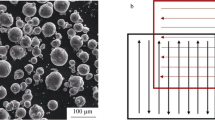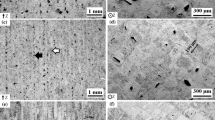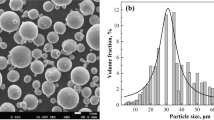Abstract
Quality and property control have become one of the critical problems for the metallic parts produced by selective laser melting. In this paper, the crack spontaneously formed in the Ti-6Al-4V alloy by selecting laser melting is investigated. The crack is C-shape without branching in macro view. In micro view, the crack originates from and propagates toward the selective laser melting (SLM) processing defects. The crack surface topography shows that the crack is typical dimple cleavage. A few heads of martensitic α′ laths appear at the bottom of the dimple. And the secondary crack nucleates and grows up near by the martensitic α′ laths. A lot of spatters and cavities formed at the top surface of the SLM body and the residual stress accumulated in the SLM body is up to 640 MPa, which confirms that the SLM processing defects and the residual stress induced the origination and propagation of the crack. The research results indicate that preventing spatter and controlling residual stress are important to SLM processing.






Similar content being viewed by others
Change history
21 August 2021
A Correction to this paper has been published: https://doi.org/10.1007/s42864-021-00115-4
References
Sheng H, Sing SL, de Looze G, Wilson R, Yeong WY. Laser powder bed fusion of titanium-tantalum alloys: compositions and designs for biomedical applications. J Mech Behav Biomed Mater. 2020;108:103775.
Nie XJ, Chen Z, Qi Y, Zhang H, Zhang CC, Xiao ZX, Zhu HH. Effect of defocusing distance on laser powder bed fusion of high strength Al-Cu-Mg-Mn alloy. Virtual Phys Prototy. 2020;15(3):325.
Maietta S, Gloria A, Improta G, Richetta M, De Santis R, Martorelli M. A further analysis on Ti6Al4V lattice structures manufactured by selective laser melting. J Healthc Eng. 2019;2019:3212594.
Razavi SMJ, Ferro P, Berto F, Torgersen J. Fatigue strength of blunt V-notched specimens produced by selective laser melting of Ti-6Al-4V. Theor Appl Fract Mech. 2018;97:376.
Sun DS, Gu DD, Lin KJ, Ma J, Chen WH, Huang J, Sun XF, Chu MQ. Selective laser melting of titanium parts: influence of laser process parameters on macro- and microstructures and tensile property. Powder Technol. 2019;342:371.
Sing SL, Yeong WY. Laser powder bed fusion for metal additive manufacturing: perspectives on recent developments. Virtual Phys Prototy. 2020;15(3):359.
Benedetti M, Plessis AD, Ritchie RO, Dallago M, Razavi SMJ, Berto F. Architected cellular materials: a review on their mechanical properties towards fatigue-tolerant design and fabrication. Mater Sci Eng R. 2021;144:100606.
Dai NW, Zhang LC, Zhang JX, Chen QM, Wu ML. Corrosion behavior of selective laser melted Ti-6Al-4V alloy in NaCl solution. Corros Sci. 2016;102:484.
Li XD, Li CF, Liu YM, Liu BY, Ni JQ. Fracture behavior under tensile loading of Ti-6Al-4V alloy manufactured by selective laser melting processing. Chin J Rare Met. 2019;45(3):279.
Wilson-Heid AE, Wang ZQ, McCornac B, Beese AM. Quantitative relationship between anisotropic strain to failure and grain morphology in additively manufactured Ti-6Al-4V. Mater Sci Eng A. 2017;706:287.
Razavi SMJ, Van Hooreweder B, Berto F. Effect of build thickness and geometry on quasi-static and fatigue behavior of Ti-6Al-4V produced by electron beam melting. Addit Manuf. 2020;36:101426.
Long RS, Sun SN, Lian ZS. Crack restriction mechanism of thin wall metal parts fabricated by laser direct deposition shaping. Mater Sci Technol. 2016;32(6):523.
Ali H, Ma L, Ghadbeigi H, Mumtaz K. In-situ residual stress reduction, martensitic decomposition and mechanical properties enhancement through high temperature powder bed pre-heating of selective laser melted Ti6Al4V. Mater Sci Eng A. 2017;695:211.
Ali H, Ghadbeigi H, Mumtaz K. Effect of scanning strategies on residual stress and mechanical properties of Selective laser melted Ti6Al4V. Mater Sci Eng A. 2018;712:175.
Deng DY, Eriksson R, Peng RL, Moverare J. On the dwell-fatigue crack propagation behavior of a high-strength Ni-base superalloy manufactured by selective laser melting. Metall Mater Trans. 2020;51:962.
Qbau N, Nam ND, Ca NX, Hien NT. The crack healing effect of scandium in aluminum alloys during laser additive manufacturing. J Manuf Processes. 2020;50:241.
Waddell M, Walker K, Bandyopadhyay R, Kapoor K, Mallory A, Xiao XH, Chuang AC, Liu QC, Phan N, Sangid MD. Small fatigue crack growth behavior of Ti-6Al-4V produced via selective laser melting: In situ characterization of a 3D crack tip interactions with defects. Int J Fatigue. 2020;137:105638.
Razavi SMJ, Berto F. Directed energy deposition versus wrought Ti-6Al-4V: a comparison of microstructure, fatigue behavior, and notch sensitivity. Adv Eng Mater. 2019;21:1900220.
Shi WT, Wang P, Liu YD, Shi XZ. Crack initiation mechanism and experiment study of process optimization of TiAl alloy formed by selective laser melting. Chin J Rare Met. 2019;43(4):349.
du Plessis A, Razavi SMJ, Berto F. The effects of microporosity in struts of gyroid lattice structures produced by laser powder bed fusion. Mater Des. 2020;194:108899.
Zhang MK, Yang YQ, Wang D, Xiao ZF, Song CH, Weng CW. Effect of heat treatment on the microstructure and mechanical properties of Ti6Al4V gradient structures manufactured by selective laser melting. Mater Sci Eng A. 2018;736:288.
He JJ, Li DS, Jiang WG, Ke LM, Qin GH, Ye Y, Qin QH, Qiu DC. The martensitic transformation and mechanical properties of ti6al4v prepared via selective laser melting. Materials. 2020;12(2):321.
Rani AMA, Azam FI, Ginta TL, Sallih N, Ahmad A, Yunus NA, Zulkifli TZA. Effect of unit cell type and pore size on porosity and mechanical behavior of additively manufactured Ti6Al4V scaffolds. Materials. 2018;11(12):2402.
Hattal A, Chauveau T, Djemai M, Fouchet JJ, Bacroix B, Dirras G. Effect of nano-yttria stabilized zirconia addition on the microstructure and mechanical properties of Ti6Al4V parts manufactured by selective laser melting. Mater Des. 2019;180:107909.
He YN, Montgomery C, Beuth J, Webler B. Melt pool geometry and microstructure of Ti6Al4V with B additions processed by selective laser melting additive manufacturing. Mater Des. 2019;183:108126.
Maizza G, Caporale A, Polley C, Seitz H. Micro-macro relationship between microstructure, porosity, mechical properties, and build mode parameters of a selective-electron-beam-melted Ti-6Al-4V alloys. Metals. 2019;9(7):786.
Carroll BE, Palmer TA, Beese AM. Anisotropic tensile behavior of Ti-6Al-4V components fabricated with directed energy deposition additive manufacturing. Acta Mater. 2015;87:309.
Li J, Li ZL, Shi YY, Wang HR, Li RL, Tu JP, Jin G. In vitro and in vivo comparisons of the porous Ti6Al4V alloys fabricated by the selective laser melting technique and a new sintering technique. J Mech Behav Biomed Mater. 2019;91:149.
Maszybrocka J, Gapinski B, Dworak M, Skrabalak G, Stwora A. The manufacturability and compression properties of the schwarz diamond type Ti6Al4V cellular lattice fabricated by selective laser melting. Int J Adv Manuf Technol. 2019;105(7–8):3411.
Xu YL, Zhang DY, Hu ST, Chen RP, Gu YL, Kong XS, Tao JM, Jiang YJ. Mechanical properties tailoring of the topology optimized and selective laser melting fabricated Ti-6Al-4V lattice structure. J Mech Behav Biomed Mater. 2019;99:225.
Zhou B, Zhou J, Li HX, Lin F. A study of the microstructures and mechanical properties of Ti6Al4V fabricated by SLM under vacuum. Mater Sci Eng A. 2018;724:1.
Kadirgama K, Harun WSW, Tarlochan F, Samykano M, Ramasamy D, Azir MZ, Mehboob H. Statistical and optimize of lattice structures with selective laser melting (SLM) of Ti6AL4V material. Int J Adv Manuf Technol. 2018;97(1–4):495.
Zhao ZY, Li L, Bai PK, Jin Y, Wu LY, Li J, Guan RG, Qu HQ. The heat treatment influence on the microstructure and hardness of tc4 titanium alloy manufactured via selective laser melting. Materials. 2018;11(8):1318.
Liang ZL, Sun ZG, Zhang WS, Wu SK, Chang H. The effect of heat treatment on microstructure evolution and tensile properties of selective laser melted Ti6Al4V alloy. J Alloys Compd. 2019;782:1041.
Dallago M, Zanini F, Carmignato S, Pasini D, Benedetti M. Effect of the geometrical defectiveness on the mechanical properties of SLM biomedical Ti6Al4V lattices. Procedia Structural Integrity. 2018;13:161.
Acknowledgements
This work was financially supported by the Science and Technology Commission of Shanghai Municipality (Grant Nos. 17JC1400600, and 17JC1400601) and the National Natural Science Foundation of China (Grant No. 51471105).
Author information
Authors and Affiliations
Corresponding author
Additional information
Publisher's Note
Springer Nature remains neutral with regard to jurisdictional claims in published maps and institutional affiliations.
Rights and permissions
About this article
Cite this article
Zhang, HY., Liu, YH., Li, ZW. et al. Crack analysis in Ti-6Al-4V alloy produced by selective laser melting. Tungsten 3, 361–367 (2021). https://doi.org/10.1007/s42864-021-00100-x
Received:
Revised:
Accepted:
Published:
Issue Date:
DOI: https://doi.org/10.1007/s42864-021-00100-x




